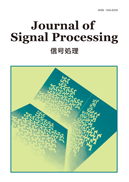Volume 25, Issue 4
Special Issue on Papers Awarded the Student Paper Award at NCSP'21 (Editor-in-Chief: Keikichi Hirose, Editor: Tetsuya Shimamura, Guest Editor: Yoko Uwate, Honorary Editor-in-Chief: Takashi Yahagi)
Displaying 1-7 of 7 articles from this issue
- |<
- <
- 1
- >
- >|
-
Reservoir Computing on Atomic Switch Arrays with High Precision and Excellent Memory Characteristics2021Volume 25Issue 4 Pages 123-126
Published: July 01, 2021
Released on J-STAGE: July 01, 2021
Download PDF (847K) -
2021Volume 25Issue 4 Pages 127-131
Published: July 01, 2021
Released on J-STAGE: July 01, 2021
Download PDF (1235K) -
2021Volume 25Issue 4 Pages 133-136
Published: July 01, 2021
Released on J-STAGE: July 01, 2021
Download PDF (842K) -
2021Volume 25Issue 4 Pages 137-140
Published: July 01, 2021
Released on J-STAGE: July 01, 2021
Download PDF (731K) -
2021Volume 25Issue 4 Pages 141-144
Published: July 01, 2021
Released on J-STAGE: July 01, 2021
Download PDF (795K) -
2021Volume 25Issue 4 Pages 145-149
Published: July 01, 2021
Released on J-STAGE: July 01, 2021
Download PDF (750K) -
2021Volume 25Issue 4 Pages 151-154
Published: July 01, 2021
Released on J-STAGE: July 01, 2021
Download PDF (916K)
- |<
- <
- 1
- >
- >|
